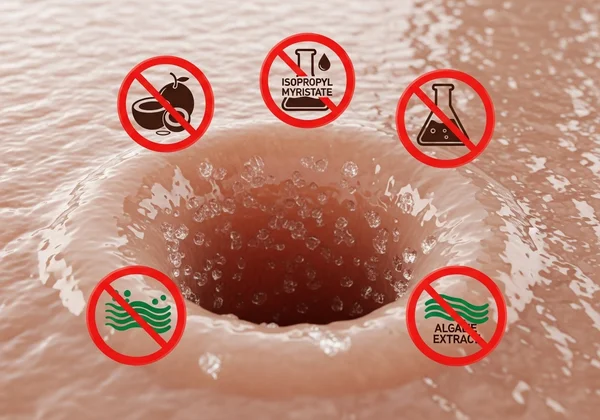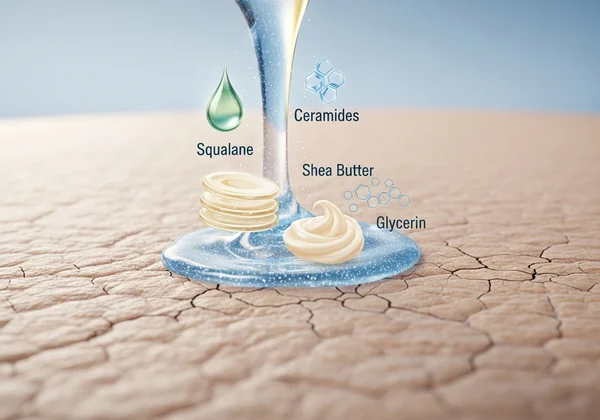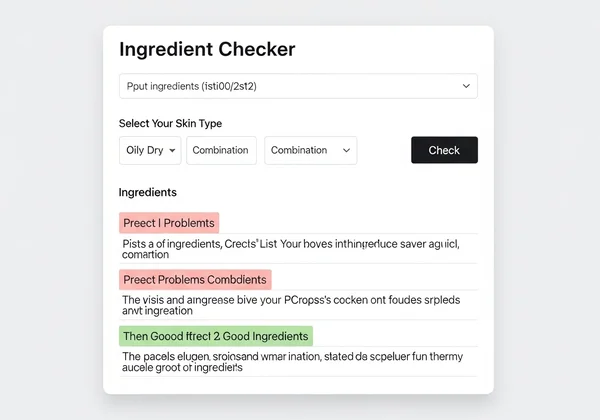究極の毛穴詰まり成分チェックガイド:あなたの肌タイプに合わせて
クリアな肌を約束するスキンケア製品を使っても、ニキビやフラストレーションが増えるばかりでうんざりしていませんか?「ノンコメドジェニック」の認証マークを熱心にチェックしても、それでも肌荒れが改善されない…という経験はありませんか?実は、その人気のラベルは、すべての人に当てはまる万能の保証ではないのです。オイリー肌、乾燥肌、混合肌など、あなたのユニークな肌タイプがさまざまな成分とどのように相互作用するかを理解することが、毛穴詰まりを防ぐ真の鍵となります。 ノンコメドジェニック製品は、本当に「すべての」肌タイプに安全なのでしょうか?
このガイドでは、マーケティングの主張を超えて、より健康的でクリアな肌のための、賢くパーソナルな選択をサポートします。「ノンコメドジェニック」があなたにとって本当に何を意味するのかを解き明かし、あなたの肌が喜ぶ—あるいは避けるべき—特定の成分を特定する方法を示します。強力な 毛穴詰まりチェッカー であなたのスキンケアを見直し、隠れた原因を明らかにする準備をしましょう。
コメドジェニックの理解と、あなたの肌タイプがなぜ重要なのか
効果的に製品を選ぶ前に、基本的な概念を理解することが不可欠です。クリアな肌への道のりは、希望だけでなく、知識から始まります。この基本的な理解は、あなた自身が最適なスキンケアを見つけるための知識と自信を与えてくれます。
「ノンコメドジェニック」とは本当にどういう意味か?
「コメドジェニック」とは、成分が毛穴を詰まらせ、コメド(黒ずみや白ニキビ)の原因となる可能性を指します。「ノンコメドジェニック」と表示されている製品は、これらの既知の毛穴詰まり成分を避けるように処方されていることを意味します。しかし、これはFDAによって規制された用語ではありません。評価システムは、数十年前に実施された研究に基づいていることが多く、製品全体の処方によって、単一成分の効果が変わる可能性があるのです。
これを、絶対的なルールではなく、役立つガイドラインと考えてください。オイリー肌の人にとって問題となる成分は、乾燥肌の人にとっては全く問題ない、あるいは有益である可能性さえあります。ここで、真に効果的なスキンケアのために、ご自身の肌での検証が不可欠です。
あなたの肌のユニークなニーズが成分選択に影響する理由
あなたの肌はユニークなエコシステムです。オイリー肌は自然に多くの皮脂を生成し、それが古い角質細胞やバクテリアと混ざり合って毛穴に詰まりを形成しやすくなります。そのため、オイリー肌の人は、この過剰な油分を閉じ込める可能性のある重く閉塞性のある成分に、より敏感です。
逆に、乾燥肌は皮脂が不足しており、水分バリアを維持するためによりリッチなオイルやエモリエントが必要です。これらの成分は保湿に不可欠ですが、慎重に選ばなければコメドジェニックになるものもあります。肌の基本的な状態を理解することが、肌と調和し、逆らわないルーティンを作り上げるための第一歩です。 コメドジェニック成分チェッカー を使用することで、あなた自身でこれらのパターンを見始めることができます。

オイリー肌のためのノンコメドジェニック:探すべき成分と避けるべき成分
オイリーでニキビができやすい肌の管理は、しばしばデリケートなバランス調整のように感じられます。肌に重さを感じさせずに保湿し、肌の保護バリアを剥ぎ取ることなく毛穴をクリアに保つ必要があります。鍵は、あなたの肌の自然な状態を尊重する成分を選ぶことです。
オイリー・ニキビ肌に最適な軽量保湿剤と有効成分
オイリー肌の場合、目標は水ベースの保湿を提供し、細胞のターンオーバーをサポートすることです。これらのパワフルな成分を含むジェルクリーム、セラム、ローションを探しましょう。
- ヒアルロン酸: 肌に油分を加えることなく、水分を引き込む保湿剤です。
- ナイアシンアミド: このビタミンB3誘導体は、皮脂の生成を調節し、炎症を軽減し、肌の質感を改善するのに役立ちます。
- サリチル酸 (BHA): 油溶性の角質除去剤で、毛穴の奥深くまで浸透し、皮脂や老廃物をクリアにします。
- 緑茶エキス: 皮脂の生成を抑え、赤みを落ち着かせるのに役立つ、肌を鎮静させる抗酸化物質です。
これらの成分は、オイリー肌がバランスを保ち、クリアな状態を維持するために必要な水分とトリートメントを提供します。
オイリー肌が避けるべき一般的な毛穴詰まりの原因
一部の成分、天然成分でさえ、オイリー肌タイプで毛穴の詰まりを引き起こすことで悪名高いものがあります。普遍的に悪いわけではありませんが、注意すべき一般的なトリガーです。新しい製品を購入する前に、これらの潜在的な原因について 成分をチェック 成分をチェック することをお勧めします。
-
ココナッツオイル: ほとんどの人にとって非常にコメドジェニックであり、重く感じられ、肌の油分を閉じ込め、毛穴詰まりを引き起こす可能性があります。
-
ミリスチン酸イソプロピル: ローションによく含まれるエモリエントで、毛穴を詰まらせ、ニキビを引き起こすことが知られています。
-
藻エキス: 保湿効果がありますが、特定のタイプは皮脂の生成を促進し、非常にコメドジェニックである可能性があります。
-
ラウリン酸: ココナッツオイルの主要成分である脂肪酸で、毛穴を詰まらせる可能性が高いです。

乾燥肌のための成分:毛穴を詰まらせずに潤す
乾燥肌の場合、主な目標は深く持続的な潤いを確保することです。課題は、あなたが求めるリッチで栄養価の高い成分の多くに、隠れた毛穴詰まりの原因が含まれている可能性があることです。予期せぬニキビにつながることなく、肌のバリアを強化するエモリエントが必要です。
乾燥肌のための保湿ヒーロー:エモリエントと保湿剤
乾燥肌は、水分を閉じ込め、肌のバリア機能を健やかに保つ成分で効果を発揮します。これらのヒーローは栄養を提供し、ほとんどの人にとって一般的に安全と考えられていますが、 ニキビに安全な製品チェッカー ニキビに安全な製品チェッカー で確認するのが常に最善です。
-
スクワラン: 肌の皮脂に近い、軽やかなノンコメドジェニックオイルで、べたつかずに潤いを与えます。
-
セラミド: これらの脂質は肌のバリアに不可欠で、水分の保持と環境刺激からの保護を助けます。
-
シアバター: コメドジェニック評価は低いですが、肌を深く潤します。乾燥肌の人に多く効果がありますが、特に敏感な場合は確認することをお勧めします。
-
グリセリン: 肌に水分を引き込み、肌をふっくらと潤った状態に保つ強力な保湿剤です。

乾燥肌用製品に紛れ込む可能性のある隠れたコメドジェニック成分
乾燥肌向けに処方された製品でさえ、あなたに合わない可能性のある成分が含まれていることがあります。リッチなクリームやオイルには、栄養価が高いものの、コメドジェニックのリスクが中程度である成分が含まれていることがよくあります。エチルヘキシルパルミテートや小麦胚芽油など、一部の人には問題となる可能性のある成分に注意してください。保湿効果を謳っているからといって、毛穴詰まりの観点から完全に安全だと仮定しないでください。
混合肌の毛穴詰まりを乗り切る:バランスの取れたアプローチ
混合肌はユニークな課題をもたらします。同時に、油っぽさと乾燥の両方に対処しなければなりません。Tゾーン(額、鼻、あご)はニキビができやすいかもしれませんが、頬はつっぱり感があり乾燥しているかもしれません。これには、戦略的でバランスの取れたスキンケアアプローチが必要です。
混合肌ゾーンの理解
最初のステップは、顔のマップを作成することです。Tゾーンと頬が異なるニーズを持っていることを認識してください。これは、完全に別々の2つのルーチンが必要であることを意味するわけではありませんが、どちらの肌悩みも悪化させない処方を優先することが大切です。重いクリーム1つは鼻を詰まらせる可能性があり、刺激の強いニキビ治療は頬を乾燥させる可能性があります。
バランスの取れた処方を選択するための戦略
閉塞性がないまま保湿を提供する、軽量なローションやジェルクリームを探しましょう。ナイアシンアミドのような成分は、Tゾーンの皮脂を調節しながら、乾燥した部分の肌バリアをサポートするため、混合肌に最適です。頬にはよりリッチでノンコメドジェニックなモイスチャライザーを、Tゾーンにはより軽量なオイルフリーのフォーミュラを使用するなど、「スポットトリートメント」を試すこともできます。不明な場合は、 ノンコメドジェニックチェッカー ノンコメドジェニックチェッカー で成分リストを実行して、両方のゾーンに適していることを確認してください。
スキンタイプ成分チェッカーをパーソナライズされた結果に活用する方法
もう推測したり、一般的なラベルに頼ったりする必要はありません。適切なツールがあれば、あなた自身がスキンケアの探偵になり、パーソナライズされたデータ駆動型の洞察を得ることができます。ここでオンラインツールがすべてを変えることができます。
私たちの成分チェッカーを使用するためのステップバイステップガイド
私たちの無料ツールを使用するのは、シンプル、高速、そして力を与えてくれます。数秒で自信を持って意思決定を行うために必要な明確さを提供します。方法は次のとおりです。
-
成分をコピーする: 製品のウェブサイトまたはパッケージから、完全なコンマ区切りの成分リストを見つけます。
-
貼り付けて分析する: 私たちの 成分分析ツール 成分分析ツール にアクセスし、リストを入力ボックスに貼り付けます。
-
肌タイプを選択する: パーソナライズの鍵となります!オイリー、乾燥、または混合肌を選択して、あなたの特定のニーズに合わせた分析を取得します。
-
即座に結果を取得する: 「チェック」をクリックすると、ツールは包括的な科学データベースに基づいて、潜在的に毛穴を詰まらせる可能性のある成分を即座に強調表示します。

ラベルを超えて:なぜ公平なチェッカーが不可欠なのか
ボトルのマーケティング用語は、単なるマーケティングです。公平でデータベース駆動型のチェッカーは、宣伝文句に惑わされず、確かな情報を提供します。私たちのツールはどのブランドからもスポンサーを受けていないため、結果は完全に客観的です。科学的な知識を提供し、製品に何が含まれているか、そしてそれがあなたの特定の肌タイプにどのように影響する可能性があるかを正確に把握できるようにします。これは、 製品を分析 製品を分析 し、本当に効果のあるルーチンを構築するための最も信頼できる方法です。
パーソナライズされた成分の洞察でスキンケアジャーニーを強化しましょう
スキンケアの世界をナビゲートすることは、試行錯誤のフラストレーションのサイクルである必要はありません。「ノンコメドジェニック」は相対的な用語であり、あなたの肌タイプが究極の決定要因であることを理解することで、ニキビが発生する前に防ぐルーティンを最終的に構築できます。真の明晰さは、パーソナライズされた知識から生まれます。
推測するのをやめて、分析を始めましょう。無料の公平なツールを使用して製品をチェックすることで、今日から、あなた自身のスキンケアを最適化しましょう。
あなたのルーティンに隠された原因を明らかにしたいですか? 今すぐ無料ツールを試して 今すぐ無料ツールを試して、あなたの肌が本当に必要としているものを発見しましょう!**
ノンコメドジェニック成分に関するあなたの質問にお答えします
私の肌タイプにとって、製品が毛穴を詰まらせるかどうかを確認するにはどうすればよいですか?
最も効果的なのは、オンラインの成分分析ツールを活用することです。製品の成分リストをコピーし、 オンライン毛穴詰まりチェッカー ツールに貼り付けるだけです。最も重要なのは、あなたの特定の肌タイプ(オイリー、乾燥、または混合肌)を選択して、一般的なラベルを超えたパーソナライズされた結果を取得し、 あなたにとって 問題となる可能性のあるものを知らせることです。
私のタイプに基づいて、ニキビ肌のために避けるべき成分は何ですか?
これは大きく異なります。オイリーでニキビができやすい肌は、ココナッツオイルのような重いオイルや、ミリスチン酸イソプロピルなどの特定のエステルに注意する必要があります。乾燥肌でニキビもできやすい場合は、保湿効果はあるものの、コメドジェニック評価が中程度である、よりリッチなバターやオイルの一部を避ける必要があるかもしれません。最善のアプローチは、 ニキビ成分チェッカー ニキビ成分チェッカー を使用して、新しい製品を使用する前に各製品を分析することです。
ノンコメドジェニック製品は、本当に「すべての」肌タイプに安全ですか?
必ずしもそうではありません。「ノンコメドジェニック」は役立つ出発点ですが、すべての人にとって安全性の保証ではありません。成分の効果は、肌の自然な皮脂生成と感受性によって異なる場合があります。そのため、個人的な分析が非常に重要です。科学的なデータベースと成分を照合するツールは、マーケティングの謳い文句よりも、はるかに信頼性の高い評価を得られます。
免責事項:この記事は情報提供のみを目的としており、医学的アドバイスを構成するものではありません。個人的な肌の懸念や症状については、専門の皮膚科医にご相談ください。